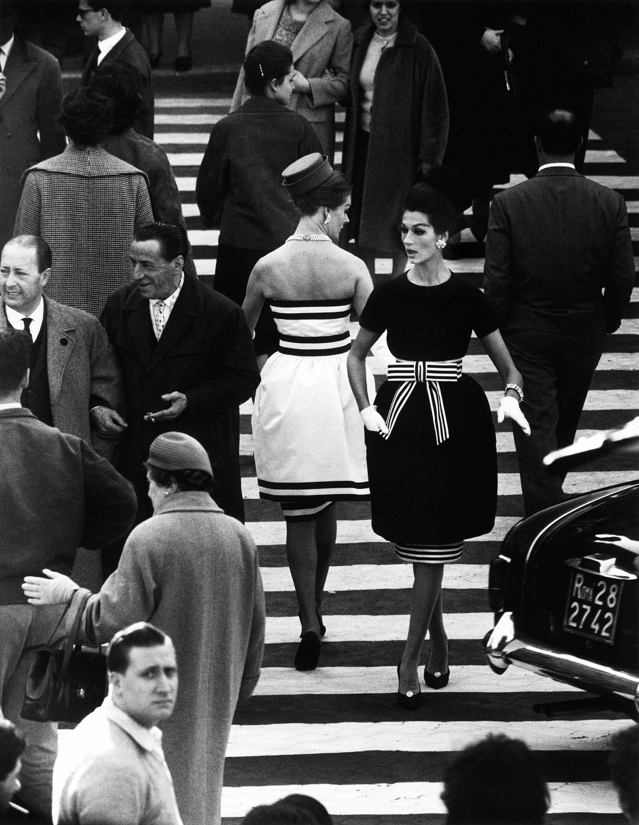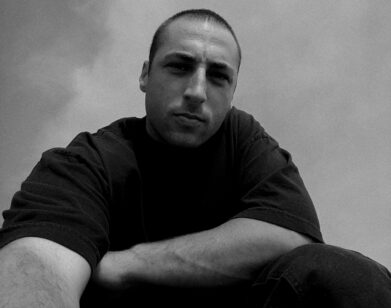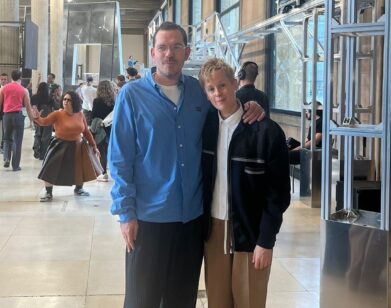A Lens on William Klein
William Klein has always colored outside the lines. With forays into experimental photography, fashion photography at Vogue, and later, film, he had few preconceived notions about the art forms, and did not care to aspire to others’ norms—his methods were mostly improvised. Trained as a painter, Klein worked briefly in Fernand Léger’s Paris studio after serving in World War II, and never received professional photographic instruction. His first venture into the medium came from a chance photograph that captured a mural on turning panels as geometric blurs. Fascinated, Klein shifted his focus to abstract photography.
His images caught the eye of American Vogue‘s art director, Alexander Lieberman, who invited him to work for the magazine in New York. Yet, even while employed by Vogue in the 1950s, he was bored by the studied photographic compositions that prevailed under Diana Vreeland’s reign. While he is best known now for his fashion photographs, he still seems skeptical of the glossed-over world they portrayed. As a native New Yorker, born and raised near Harlem, he makes it clear why: speaking to us from his home in Paris, he describes how he would enlighten jaded outsiders. “New York is a slum,” he would tell them. “You guys live on Fifth Avenue… You don’t know New York. I know New York, I’ve been walking my ass off.”
And walk, he did. Though living on Vogue‘s salary, he preferred to wander New York city streets, snapping photographs of passerby, less interested in their style—like many photographers wandering the streets today—as in moments from the lives he encountered. Klein received mostly negative feedback in New York, but his collection of New York street photographs was released by a French publishing house in 1956, leading to books on Rome and Tokyo in the next few years.
Towards the late 1950s, Klein began working with film, often using the medium to subtly criticize the frenetic energy of a New York increasingly entrenched in consumerism. His first film, Broadway by Light (1958), is considered among the first pop-art films.
In light of the recent Tate retrospective, a new exhibition, “William Klein: Paintings, Etc.” opens today at New York City’s Howard Greenberg Gallery, displaying some of Klein’s rarely seen experimental works. Additionally, New York’s The Museum of Art and Design will present a six-film series from March 1—April 25. This season also sees the release of the new book William Klein: ABC (Abrams), which traces the arc of his career.
Klein, now 84, lives in Paris, and hasn’t stopped shooting.
RACHEL SMALL: A lot of your early work is street photography, and inherent in that is spontaneity—an element that, to an extent, defines your greater body of work. When you take photographs on the street, how do you know when to click the camera?
WILLIAM KLEIN: Well, you know, I have a special relationship with God. And when I take the right photograph, God gives me a little bing! in the camera. [laughs] And then I know I’m on the right track.
SMALL: [laughs] Oh, good. Can you tell me the start of your story?
KLEIN: I had no photographic training at all. When I was working in Paris, at Fernand Léger’s studio, he’d say, “You guys are all obsessed with collectors and museums and galleries, but all that’s bullshit. What you should do is take a look at what painters did in the 15th century in Italy.” There were books on the Quattrocento, but they were expensive, and we didn’t have money so we stole them. We took what Léger told us seriously. Later, I ran into a young architect who had done panels painted on both sides separating a space. I photographed the setup as I had somebody turn the panels. The geometrical forms in the paintings blurred. Photography gave another aspect to the compositions of geometrical paintings. Then I started to become interested in what you could do in the darkroom, and I realized that this blur was adding something to painting. So I said, “Maybe I could do something with photography.”
What’s funny is that it’s usually the other way around. A guy does paintings, and discovers that his paintings are pretty shitty, and he says, “What else can I do?” He goes to photography, which is a step down. For me, it was the contrary. Photography led me to experiment in graphic work, and actually, painting. So the works I did in the darkroom were a step away from traditional painting that was fashionable at the time—Picasso and Miró and Léger, and so on. The photography was a way out of the ABCs of abstract painting from that period in Paris. It was before action painting. It was another kind of work with forms. I discovered that I could do whatever I wanted with a negative in a darkroom and an enlarger. I said, “Hey, I can say what I want about life around me,” which I couldn’t with these geometrical paintings. I could say a lot of things with photography.
SMALL: How did you make it back to New York?
KLEIN: I had a show of stock photographs. Alexander Liberman, who was the art director of Vogue, saw them, and he said, “How would you like to work for Vogue?” And I said, “Doing what?” And he said, “I don’t know, you could be the assistant art director, and work with me. Or, you could take photographs.” And I said, “Well, that sounds like [laughs], that sounds cool. Uh, I’ll take photographs. What kind of photographs?” He says “Oh, you’ll see. You’ll do portraits, you’ll do still lifes.” That’s what I did for a few months. And then he said, “Do you have a project?” And I said, “Yeah, I would like to do a portrait of New York the way I see it coming back from Paris.” And he said, “That sounds cool. We’ll finance it.” I was 23, and at 23, you think you can do anything. I did these photographs of New York any old way. That became my book on New York.
These photographs, they were kind of weird, funky, grungy… I showed them to Liberman, and he said “Well, we’ll do a portfolio.” They never did a portfolio, because these photographs were the least publishable photos possible. This was Vogue, so this was a high-class…
SMALL: More refined?
KLEIN: Very technically good photographs. I didn’t think that the fashion photographers were that good, except for Penn and Avedon, but they had their technique. I realized I had no technique. But Liberman said, “Look, we’re a fashion magazine, and we’re financing your funky photographs of New York. And what I had in the back of my mind is that one day, you’d be able to take fashion photographs which would be offbeat, and we could use. So why don’t you try to take some fashion photographs?”
So, I thought, how could I do that? [laughs] Then I had the idea of doing fashion photographs with a telephoto lens with the girls mixed up in traffic and cars. So, I did that, and Liberman said, “These are cool. Why don’t you do the collections?” Now, the collections were a big deal, you know? The whole magazine would be mobilized to go to Paris and photograph and talk about the new fashions. The guy who shot the fashion collections was Penn, who did everything against a white background in the studio. Liberman said, “Look, why don’t you take some photographs, fashion photographs, like you’ve taken for the New York photographs? You know, Vogue and Harper’s Bazaar, we are competing, and our collections are very cold. Why don’t you try and make them exciting?” And that’s what I did, and they were successful. Little by little, I started making my living taking fashion photographs, while I was still financed by Vogue to do my New York book.
SMALL: When did you start making your own films?
KLEIN: [Parisian publisher] Chris Marker’s best friend was Alain Resnais. And Resnais said to me, “Listen, you, you just made a book, you have a new way of looking at things, why don’t you do a film?” And I said, “Yeah, why not?” So, I went with a camera, and I did a film which would be opposite of my book on New York, because a lot of people criticized the fact that my book on New York was very harsh, black and white, and grungy. So I said, “I’ll do something very beautiful, which would be the contrary to the look of the New York book but would say the same things.” So I did a film which I called Broadway by Light [1958]. It was like Marcel Duchamp’s ready-made. I shot all the cycles of these lights on Broadway, which were actually commercials. You’d see the, the names of Kodak and beer, Sylvania, and so on. And it’s the first thing that tourists come and photograph or film, and, actually, it’s brainwashing. But at the same time, it was the most beautiful thing in New York. These lights and signs, Pepsi-Cola and Coca-Cola and so on and so forth, became the ABCs of pop painting and photography.
SMALL: What are your thoughts on Orson Welles describing Broadway by Light as the first film he’d seen where “color was absolutely necessary”?
KLEIN: Nowadays, to do a film in black and white is offbeat. But in those days, color was offbeat. Orson Welles had never shot a film in color until that time. Citizen Kane, and The Magnificent Andersons, and so on, they were all in black and white. He only dealt with color much later. The idea of color and black and white was still a moot question. So that was a really good compliment. [laughs]
SMALL: Yeah! The colors convey that epileptic nature of Times Square and then the sounds you added really push that really fast, frantic energy. Can you tell me about making the film?
KLEIN: I just rented a camera, and went out to shoot the signs at nighttime. Then I figured, like with photography in the beginning, once I had all this stuff together, I could make a film out of it, which is what I did. It inspired Louis Malle to ask me to work on Zazie in the Metro, because he thought my film communicated the atmosphere that he wanted to catch. In the film, you see all of the sets. Every time you see somebody inside an apartment, you see, outside, from the window, you see lights, all the lights, flashing on the road. It was inspired by a novel by a very hip French writer who was influenced by James Joyce. His language was completely invented. I thought that we should do that graphically, and in the daytime. So, at nighttime, we had the lights that could be visible in most of the movie. In the daytime, people would be in the streets, and there would be big signs advertising, and the advertising would be in a language that nobody could understand, just big letters.
SMALL: I’d love to hear more about your street photography in New York. When you were going around, did you have to explain to people what your job was?
KLEIN: Today, everybody’s photographing everybody else. But in those days, sometimes people would be surprised and say, “What are you doing?” I’d say I was doing a book that would be like the Daily Bugle—a very noisy tabloid—which, for me, corresponded to New York. I was inspired by the New York Daily News, which had a big photograph on the front page of a cop raiding someplace. So I went along with that idea. Sometimes people would stop me, and I’d say, “This is for the news!” They’d say, “What do you mean, for the news?” And I’d say, “I’m the Inquiring Photographer.” [chuckles] In the New York Daily News, on the Op-Ed page, they would have a column called the Inquiring Photographer, who would take a photograph of somebody, and they would ask, “Do you think it’s right for a man to beat his wife?” Or, “Do you think it would be terrible if the Communists came here?” And, he goes on asking them questions, and the guy who’s photographed or published would answer. So I would say to people, “I’m the Inquiring Photographer.” And they would say, “Yeah? Yeah? When are these coming out?” And I would say, “Tomorrow.” They’d say, “Tomorrow? Hey, you’re kidding!” [laughs] I’d say, “No, we work fast. You’ll see… By tomorrow, you’ll see. You’ll see your photograph.” You know, New Yorkers, maybe they’re less naïve today, but in those days, they were very naïve about photography and the press and everything. When I said “I’m working for the News…” [laughing], they’d say, “Okay, that’s cool.” I’m a New Yorker, you know, so I’d be able to bullshit with people.
SMALL: [laughs] When you met Alexander Liberman from Vogue, that was your first experience with fashion. What did you think of fashion before you started working for Vogue?
KLEIN: Well, you know, my wife was very, very beautiful. She was somebody who was stopped on the street all the time, and they would say, “You should go to Vogue and become a model.” She was also somebody from an aristocratic background and she said that [laughs] being a model was a bit like being a hooker. She never took them up on that.
But one day, we were really strapped for money, and she said, “Well, fuck it. I’ll see what can happen, I’ll go down to Vogue.” She dressed up in her best clothes, and she went to Vogue and she said, “Do you need a model?” The person at reception said, “Let’s see your book.” [laughs] “What book?” she said. “Yeah, your book of photography.” She said, “I don’t have one.” Then a guy came out of the studio. His name was Horst P. Horst, the photographer. And he said, “Hey there, beautiful creature…” And the girl at the reception said, “She doesn’t have a book.” He said, “That’s all right. Come into the studio.” So she went into the studio, and for a year and a half, she was a model.
Avedon liked her a lot. He said, “What does your husband do?” She said, “Oh, he’s a painter.” He said, “Can I come to the studio?” And Avedon came, and he dug what I was doing. Then he said, “You two must be the most beautiful couple I have ever seen.” [laughs] Then he said, “I have to do a shot with a couple kissing in front of the Sacré Coeur cathedral in Paris, do you want to do it?” So we did it. This was in 1951 or ’52. Avedon became a good friend.
SMALL: What’s your favorite part about taking photos?
KLEIN: [pauses] I feel like I’m doing something that’s worthwhile. I feel like I’m showing something other people haven’t shown. I don’t get to talk to the people who I photograph, I just go, along, banging away. So I don’t really have a relationship with them. A lot of people think it’s very important. I don’t. It’s like love at first sight. I have an impression when I see somebody, and I have an idea of who they are, or what they are… That’s the advantage of being, of photographing in New York for me. I would come back from Paris and I would look at these people and I’d say, “Oh, this is like my uncle, Sam. This is like my cousin, Norman.” I have the impression that these photographs are like instruments of psychoanalysts.
It’s the excitement of discovering people. They’re like X-rays, these photographs—I feel that I’m getting an idea of who these people are, the life they lead, and where they’re going. That’s the excitement of taking photographs of people in the street. I’m known for fashion photographs, but fashion photographs were mostly a joke for me. In Vogue, girls were playing at being duchesses, but they were actually from Flatbush, Brooklyn. They would play duchesses, and I would play Cecil Beaton.
SMALL: What is the most surprising thing someone has said to you about your work?
KLEIN: “What is all this junk?”
“WILLIAM KLEIN: PAINTINGS, ETC.” AND THE MUSEUM OF ART AND DESIGN’S WILLIAM KLEIN FILM SERIES BOTH BEGIN TODAY. WILLIAM KLEIN: ABC IS OUT NOW.







